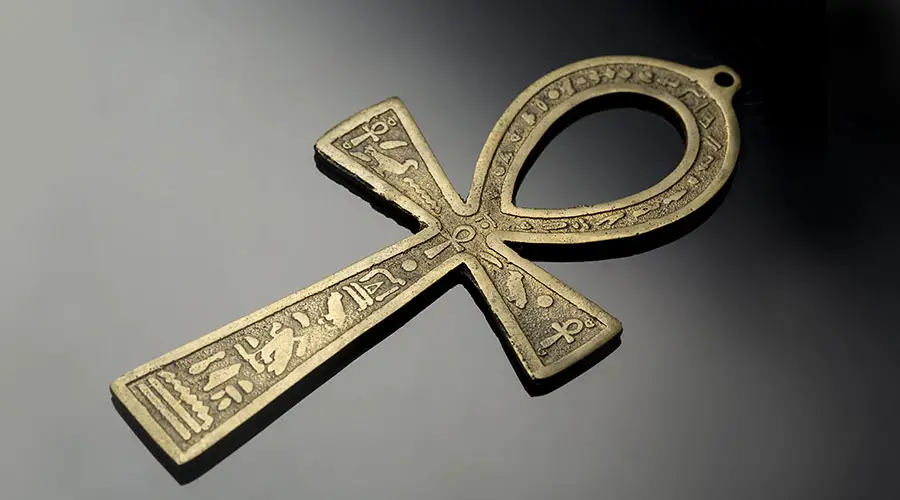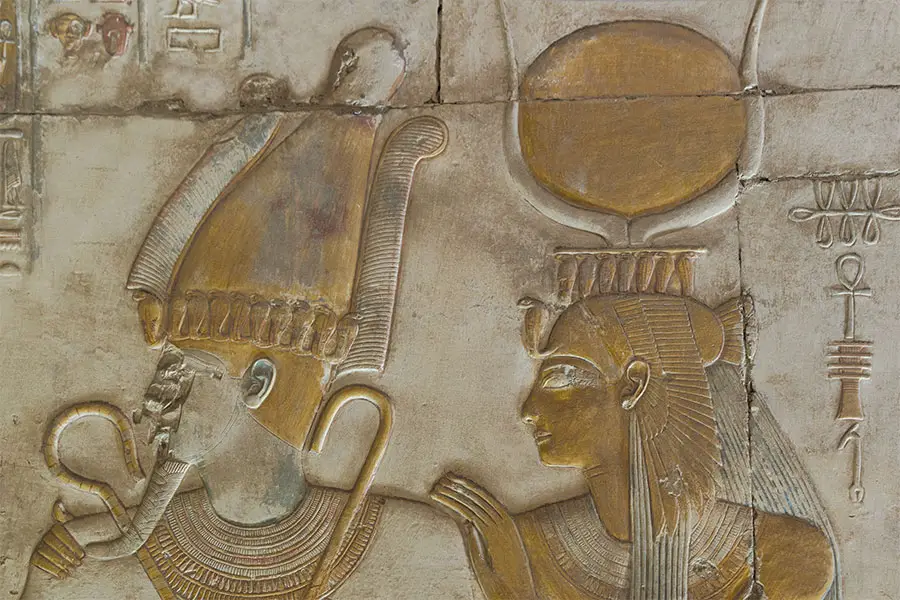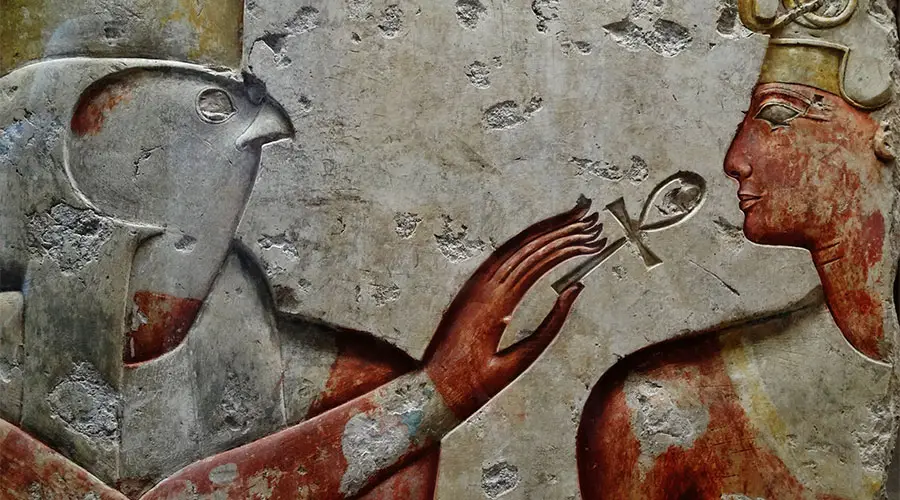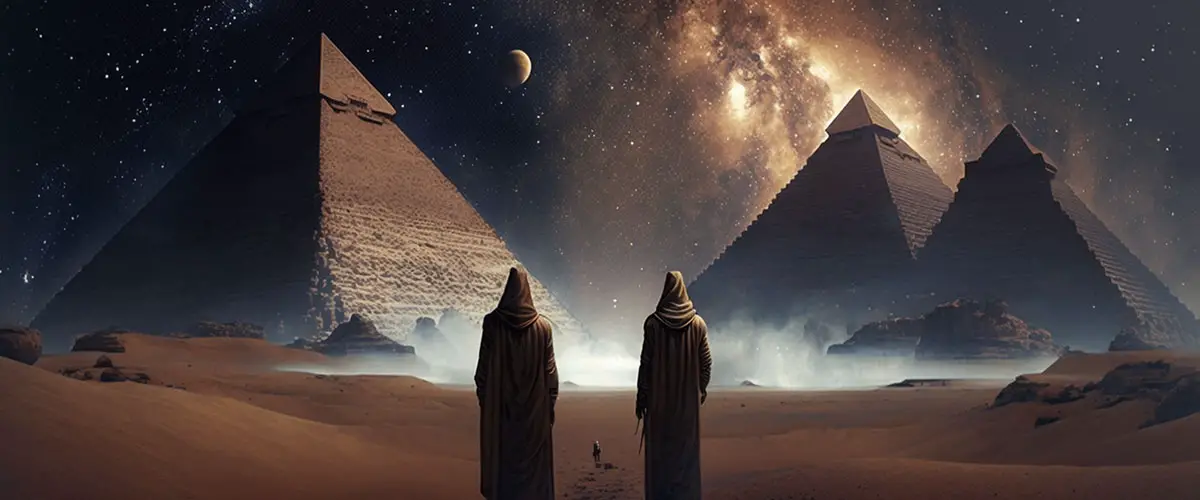The Ankh is a very powerful symbol that dates back to at least ancient Egypt, and is rich in meaning. It’s symbolism is multilayered and complex.
The ankh is the ancient Egyptian hieroglyphic symbol of eternal life. The oval at the top represents the feminine, and the cross-like part below it the masculine. Through their union the child is created, which is represented by the arms that come out from the sides.
The ankh was worn as an amulet by Egyptian priests showing the important role death and eternal life played in their philosophy. The symbol suggests great respect for the dead, and is sometimes called the “key of life”.

The Oval at the Top
At the top of the ankh is the oval shape. It is circular with no beginning or end, representing eternity. The oval is a symbol of the divine feminine. It is resting at the top above the shaft because it symbolizes a matriarchal order. The ankh can be traced back thousands of years, before the age of patriarchal systems of society, which is reflected in its meaning.
The Union of the Male and Female
The ankh represents the union of man and woman and the creation of life through this union. As discussed, the oval at the top is the divine feminine, and is shaped like a uterus. The shaft below it is the divine masculine, in reference to the phallus. Together they symbolize fertility and the creation of life that occurs when they come together.
The Holy Trinity of Mother, Father and Child
In Egyptian mythology, there is the Holy Trinity of Osiris, Isis, and Horus, the father, mother, and child.
Osiris being the divine masculine is represented in the shaft of the ankh. He was the original ruler of Egypt, before going on to become the king of the underworld. There is another hieroglyph called a Djed, which is basically just the pilar part of the ankh. It is a reference to the backbone of Osiris and symbolizes stability.
His consort is Isis, the divine feminine, which is represented in the hoop at the top of the ankh. She is a wife and mother, and protector of women and children. Another hieroglyph, called the Knot of Isis, or sometimes the Tyet, is similar to the ankh, except that the arms curve downward. It symbolizes the menstrual cycles of Isis, the divine mother and wife.
Their son is Horus. In modern occult beliefs, he is sometimes called the Crowned and Conquering Child. He is represented in the ankh as the sides coming out of the union of the masculine and feminine.
In ancient Egypt it was believed that the bond between Osiris and Isis flooded the Nile River each year, allowing for fertile crops.

The Ankh is also called the “Key of Life”
It resembles a key, which the oval at the top being the handle, and the bottom being the part that is placed inside of a keyhole. The ankh opens the door to the world of the dead or the afterlife. It is the key to the tomb during funeral ceremonies, and was placed on the lips of dead kings
The Eternity of the Afterlife
Another layer of meaning of the ankh is in reference to the eternity of the afterlife. The shaft of the ankh represents our lived experience here on earth. The horizontal lines represent crossing over to the eternal celestial realm as we ascend. The loop at the top symbolizes the celestial realm where the pharaohs would go after death. It is a circle because it is infinite with no beginning or end.
The Ankh is Found in Tomb Paintings
Paintings and inscriptions have been discovered that depict numerous deities holding the ankh symbol. Anubis and Isis were frequently portrayed placing the ankh on the lips of the freshly deceased in the afterlife.
The ankh was usually depicted as being passed from the gods to the pharaohs, suggesting that they are passing on eternal life is a gift. Through the use of the ankh, the soul would become revitalized and prepared for life after death.
Some images show the Egyptian pharaoh being fed small ankhs. Others portray the gods pouring water over the pharaoh, with the water being a stream of small ankhs, suggesting the ankh has purifying and regenerating qualities.
By the time of the Old Kingdom (2649–2130 B.C) the ankh was established as a popular symbol and was used to adorn the sarcophagi of the dead. The dead whose caskets featured the symbol were referred to as ankhu, and their caskets or sarcophagi were called neb-ankh.
Later the Egyptians used the ankh symbol to decorate mirrors, which they called nhk. The most famous ankh shaped mirror was found in the tomb of Tutankhamun, the most well-known pharaoh, who ruled from 1336 -1327 BC. Mirrors were considered important symbols in ancient Egypt, as the afterlife was a reflection of life on earth.
The goddess Maat as well as funerary statues of pharaohs are seen holding ankhs in both hands. Images of Osiris holding the ankh have also been discovered in a number of tomb paintings. Probably the deity most commonly seen with the ankh, is Isis.

The Cult of Isis
Over time, the popularity of Isis grew in Egypt and she became the most popular goddess. The cult of Isis focused on eternal life through resurrection. Prior to the worship of Isis, Osiris was the most popular, as he had died and been reborn. During the death and rebirth of Osiris, Isis had played a critical role in recovering the pieces of his body and enabling him to travel to the underworld, and it was believed that through devotion to Isis, she could enable the same rebirth in the afterlife to her worshippers.

The Coptic Christians Adopted the Ankh as Their Religion Symbol
Starting in the 200s AD, Christianity spread to Egypt. These Egyptian Christians became known as the Coptic Christians, which is a term that refers to the Coptic Orthodox church, the largest Christian body in Egypt.
These Christians found great meaning in the ankh’s reference to the afterlife because of their own beliefs in eternal life through the sacrifice and resurrection of Jesus, and they adopted the symbol to represent their religion. The Coptic cross is also called the crux ansata, which is Latin for “cross with a handle”.
The ankh is one possible origin of the cross symbol used in Christianity. Prior to the cross, the fish was used by Christians during the Roman empire to represent their faith.
Use of the Ankh in Contemporary Religions
The Ankh continues to be a popular symbol amongst various contemporary religious movements, and is often seen in jewelry and tattoos. Various neo-pagan, New Age, and Thelemic movements have embraced the ankh as an important symbol in their beliefs. It is also used by people of African descent, who point out that the original name of Egypt was Kemet, which meant “land of black faces”, and the ankh is a symbol of pride in their heritage.
Recommended Reading
If you want to continue exploring this subject more deeply, you can see which books I recommend by clicking here.

